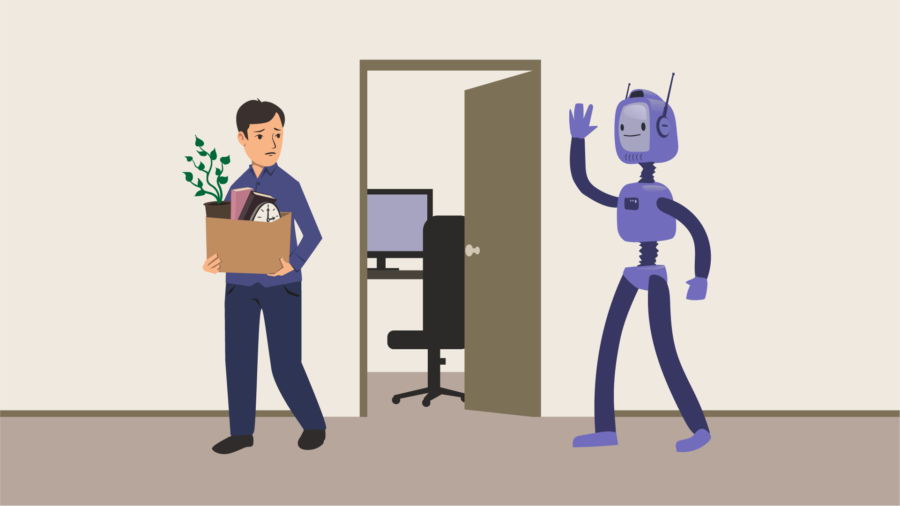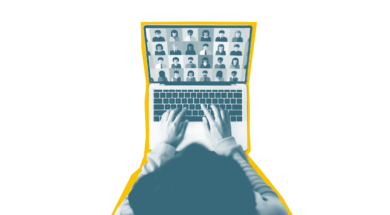
Robots will replace us!
It’s not that simple — or that scary | Brave New Work BlogBased on Toward a Systems Framework for Technology and the Future of Work by David Ticoll.
Past waves of innovation — the wheel, the powered motor and the shipping container — have drastically improved the efficiency of physical technology. These technologies changed the way we worked, but they still required humans to operate them. Today, digital technologies powered by artificial intelligence don’t require as much human supervision, if any, so it’s no surprise that research and conversations around the future of work have focused on this concern: are people about to be displaced by robots?
Estimates say 25-50% of jobs will be automated by AI-driven technologies. But labour and technology expert David Ticoll argues this “replacement by robots” theory doesn’t tell the whole story and suggests new ways to analyze changes in work — and where they may lead more broadly.
The problem with “robots will replace us” thinking
Worries that robots will replace human jobs reflect a legitimate but incomplete way of looking at the impacts of technological advances on jobs today. This analysis using labour substitution (replacing workers with machines to try to increase productivity and decrease production costs) falls short in two ways :
- Robots might replace workers in certain jobs, but some jobs could disappear entirely
When jobs and tasks are no longer needed, talk about who or what will fill the role stops making sense. If policymakers focus only on the labour substitution model to understand how jobs change, they will only end up counting jobs and sectors that still exist. Policymakers need a way of counting both jobs that change due to automation and jobs that disappear in the wake of broader industry changes.
- It doesn’t explain job growth and innovation
By definition, labour substitution focuses on the downside of technologies’ impact on employment: when workers are replaced. However, it is less good at describing the upside: how technology creates new job opportunities. It also says nothing about the jobs that humans will continue to do, and how they might change, which would help workers, employers and policymakers know what kinds of skills and competencies workers should be building now.
Labour substitution thinking misses the key question: What will the jobs of tomorrow look like?
Technologies driving disruptive product and service change
- Energy storage
- Blockchain
- DNA sequencing
- Machine learning and robotics
Three lenses to expand on labour substitution explanations
On its own, labour substitution theory and thinking won’t be enough to understand changes to jobs today or to estimate what future jobs might look like. We need a different model that looks at multi-dimensional changes in work, jobs and ways of doing business. David Ticoll looked at three additional lenses that can be applied to the future of work:
- Disruption in products and services
Substitution models make products and services, and how they are produced, seem like they are unlikely to change. But product and service innovations can drive changes to production processes.

Consider a digital product we see everywhere – the camera. Analog photography fundamentals remained unchanged for nearly 150 years after Louis Daguerre invented cameras that used silvered copper plates. A small group of companies, including Kodak, came to dominate the photography business until the invention of the first digital camera in 1975. Over the ensuing 25 years, Kodak shed more than 125,000 jobs and filed for bankruptcy in 2012. Product — not labour — digitization led to these job losses, and once product digitization had taken hold, productivity investments in film photography were money down the drain.
New products and services also create new types of work and jobs that often require different skills and talents. For example, digital photography led to new products, services and jobs in software engineering, electronics and digital media.
- Change in business models
Productivity innovations don’t happen in a vacuum. Innovative business models — the ways businesses create value for customers and turn market opportunities into profit through their relationships and activities — leverage new technologies that alter entire industries, and it impacts on jobs significantly. When companies adopt new technologies ahead of others, they can capture a market quickly, achieve near monopolies in various spheres of activity, diversify into non-adjacent sectors, and generate highly profitable revenue streams.
Who’s next?
- Sectors like retail, music and travel have already been disrupted by digital business models.
- Banking, insurance, real estate, supply chain and transportation — among others — are next.
Business models for leading digital organizations of today are very different from traditional companies. In 1986, Canadian newspapers made 80% of their revenue from selling 50-60% of their print space to advertisers. The advent of digital ads ushered in a very different business model, based on tracking the online actions of consumers and targeting ads to them. Advertisers pays a higher fee if the consumer clicks on the ad or makes a purchase. Companies like Google and Facebook, which first used these digital business models, quickly dominated this market and radically shifted advertising away from print media. Since 2000, Canadian print journalism and publishing jobs have declined by more than half.
- Business ecosystems
The third area that is often overlooked in future of work discussions is the network of relationships that make up the business ecosystem.
The world of business is highly connected — far more than ever before. The effects of product, service and business model changes ripple far from their source through supply chains, value networks and business ecosystems. These effects are sometimes not noticeable for years.
 For example, the standardized shipping container of the 1970s made the delivery of goods much faster and cheaper and transformed the business ecosystem of the global supply chain. Supported by new computer software, standardized shipping containers allowed companies to shift manufacturing to China and other low-cost locations. Retailers like Walmart seized these opportunities and captured markets based on low prices and rapid replenishment. The impact on the business ecosystem included company closures, job losses and declining incomes in the North American manufacturing and retail sectors and, conversely, boosted business and job creation in China.
For example, the standardized shipping container of the 1970s made the delivery of goods much faster and cheaper and transformed the business ecosystem of the global supply chain. Supported by new computer software, standardized shipping containers allowed companies to shift manufacturing to China and other low-cost locations. Retailers like Walmart seized these opportunities and captured markets based on low prices and rapid replenishment. The impact on the business ecosystem included company closures, job losses and declining incomes in the North American manufacturing and retail sectors and, conversely, boosted business and job creation in China.
A simple technology innovation — the standardized shipping container — deployed to improve efficiency in the shipping industry, transformed the landscape of competition and jobs worldwide.
Putting it all together: A systems approach
If we look only at how workers could be replaced by new technologies, we will miss much larger trends that will determine the future of our work, jobs and skills. As technologies and business models change, these additional three dimensions will help identify risks and opportunities for labour markets and skills development:
- Products and services
- Business models
- Ecosystems
David Ticoll points out there are even more issues to consider. To fully understand where stable, well-paying jobs will come from, policymakers need to consider demographic trends, policy choices and climate change as well. They should pay attention to the interaction between different drivers of change and how they depend on one another. Getting to this big picture will require innovative methods and tools to research, analyze and develop effective public policies to address the many uncertainties related to the future of work.
To learn more, read Toward a Systems Framework for Technology and the Future of Work, David Ticoll’s Labour Market Information Council LMI Insight article.
Adapted by Marlena Flick, Public Policy Forum
Thank you to our Brave New Work project lead sponsor:
 |
Thank you to our partners:
 |
 |
 |
 |
 |
 |
 |
 |






